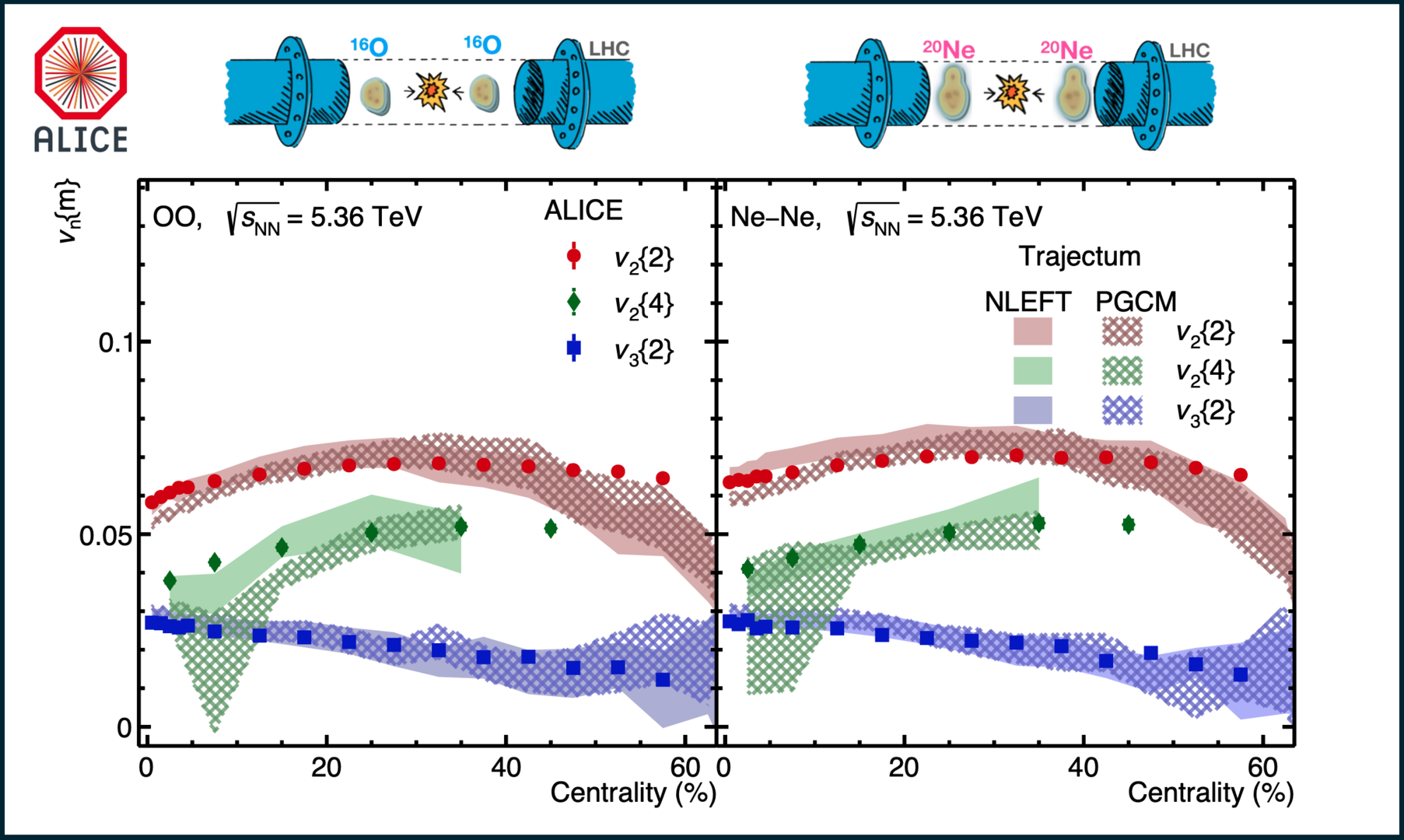
8 September 2025: ALICE Collab., “Evidence of nuclear geometry-driven anisotropic flow in OO and Ne−Ne collisions at √sNN = 5.36 TeV”, https://arxiv.org/abs/2509.06428
First evidence of geometry-driven flow in collisions of Oxygen and Neon ions at the LHC:
The Large Hadron Collider mainly collides protons, but once a year it switches to colliding heavy ions, such as lead nuclei – a key ingredient for understanding the quark-gluon plasma (QGP), the primordial soup. But in early July, something new happened: the LHC collided oxygen-oxygen (OO) as well as neon-neon (Ne-Ne) - for a few days - bridging the gap between proton and lead ion collisions. Data from OO and Ne–Ne collisions at a center-of-mass energy per nucleon pair of 5.36 TeV enabled the ALICE collaboration to observe, for the first time, geometry-driven hydrodynamic flow in small systems.
One of the most powerful tools for probing the properties of this strongly interacting medium is anisotropic flow, which reflects how the initial spatial asymmetries of the colliding system are converted into momentum anisotropies in the produced particles. Remarkably, hydrodynamic model calculations have described these flow patterns with high precision, allowing physicists to extract key transport properties of the QGP, such as its specific shear viscosity, and to establish that the QGP behaves like a nearly perfect liquid.
Systematic measurements of anisotropic flow have been carried out at LHC in small collision systems, such as proton-proton (pp) and proton-lead (p–Pb), which show features reminiscent of those seen in heavy-ion (lead-lead or xenon-xenon) collisions. However, there is ongoing debate about whether these tiny systems can create a liquid capable of building up pressure to drive radial expansion. Theoretical models are currently limited by our knowledge of the proton’s sub-nucleonic spatial structure.

Theoretical calculations: Giacalone et al., PRL, 135, 012302 (2025)
As the nuclear structures of 16O and 20Ne are better established, the hydrodynamic models incorporate the realistic inputs from low-energy nuclear structure physics, including the intrinsic geometry of these nuclei. As a result, collisions involving these nuclei provide a controlled environment to test whether collective flow truly emerges in small systems, thereby offering a decisive test of the hydrodynamic paradigm at the LHC.
ALICE has measured elliptic flow (v2) and triangular flow (v3) in OO and Ne–Ne collisions at 5.36 TeV per nucleon pair. The results, shown in Fig. 1, reveal that both v2 and v3 are sizable, and these flow coefficients exhibit a highly non-trivial dependence on collision centrality. As seen from the figure, the v2 and v3 magnitudes and trends are well described by state-of-the-art hydrodynamic model predictions. The level of agreement between theory and data equals or surpasses the accuracy observed in heavy-ion collisions at the LHC, despite the much smaller system size. The success of these models in describing the measured anisotropic flow provides strong evidence that the observed collectivity in OO and Ne-Ne collisions is driven by nuclear geometry. These findings demonstrate that hydrodynamic flow emerges robustly across collision systems at the LHC, from the largest Pb–Pb to much lighter ions.
Moreover, by taking the ratio of the flow coefficients measured in Ne–Ne and OO collisions, the influence of final-state effects is largely reduced. Comparing this ratio with state-of-the-art model calculations demonstrates a sensitivity to large and small scales of the nuclear geometry, such as deformation and the sub-nucleon structure inside 16O and 20Ne. Taken together, these results open an exciting new window on nuclear structure studies at ultrarelativistic energies.


